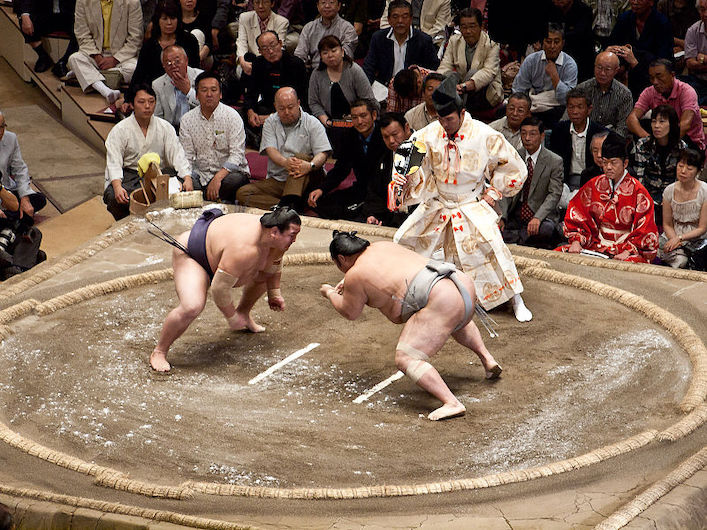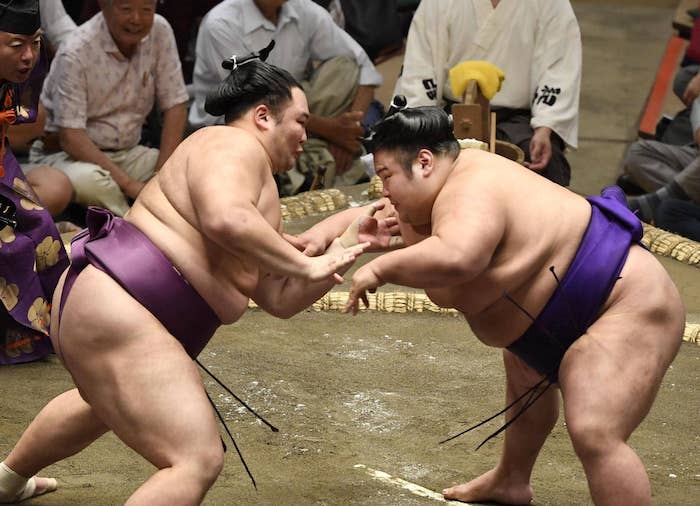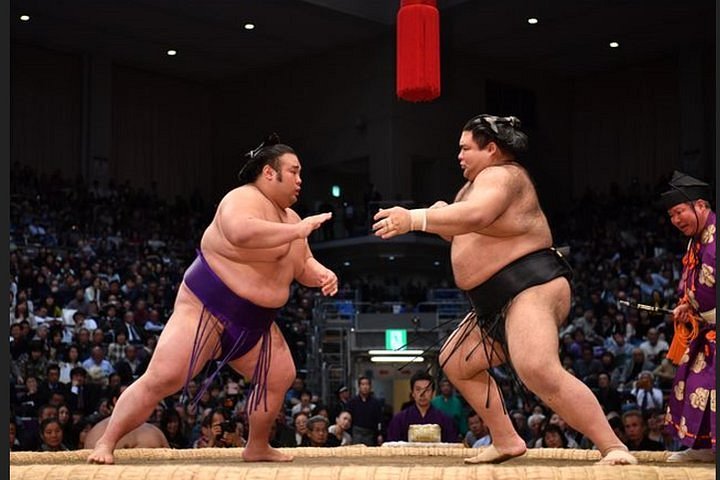Sumo wrestling is a traditional sport that originated in Japan thousands of years ago. In this sport, two wrestlers compete against each other in a ring. The goal is to force the opponent out of the ring or make them touch the ground with any part of their body aside from the soles of their feet.
One of the unique requirements of Sumo wrestling is the weight of the wrestlers. Sumo wrestlers are expected to be large and carry significant amounts of body fat. In fact, the ideal weight for a Sumo wrestler is around 400 pounds. However, the weight categories can range from 300 to over 500 pounds.
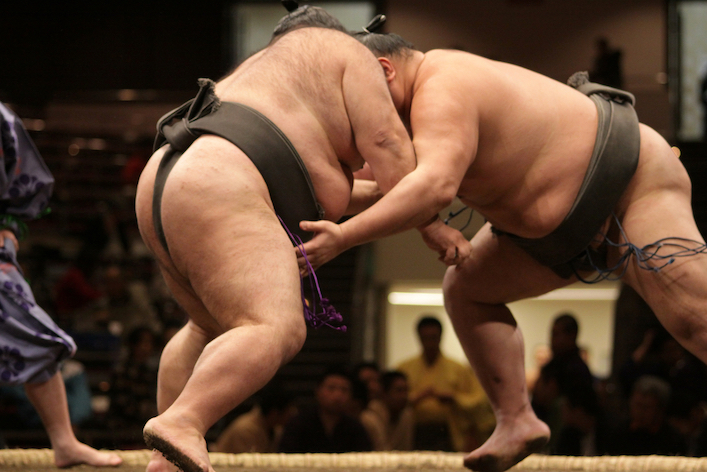
Maintaining weight is crucial for Sumo wrestlers. They are required to maintain their weight class throughout the year, even during the off-season. If a wrestler gains too much weight or falls below the required weight, they will be disqualified from tournaments.
Sumo wrestlers follow a strict diet and training regimen to maintain their weight. The diet consists of mainly rice and meat, which are high in calories and protein. They also consume a lot of beer to increase their appetite and aid digestion.
In addition to their diet, Sumo wrestlers engage in intense physical training to build muscle and maintain their weight. They practice for about six hours a day, five days a week. Their training includes practicing various techniques and exercises like shiko, where they stomp their feet to strengthen their legs.
Maintaining weight is crucial to the success of Sumo wrestlers. They follow a strict diet and training regimen to keep their weight in the desired range and be ready for the intense competition.
The Sumo Diet – A High-Calorie Intake Plan
Sumo wrestling is an ancient Japanese sport that has gained a lot of popularity in recent years. As we know, one of the most prominent features of a sumo wrestler is their gigantic size and weight, which can range from 300 to 600 pounds. This leads us to wonder, how do they maintain this weight? Let’s delve into the sumo diet and understand how wrestlers manage to pack on pounds.
Sumo wrestlers are required to put on an enormous amount of weight to compete in their weight classes. To do so, they follow a very particular diet. It may come as no surprise that this diet is very high in calories, providing them with the necessary energy to train and put on weight.
On average, a sumo wrestler consumes around 5000-7000 calories per day, which is over twice the recommended amount for an average adult male. The wrestlers aim to gain around one or two pounds every week, and the desired weight gain is usually between 20-25 pounds.
The Types of Food Consumed by Sumo Wrestlers
The traditional sumo diet is centered around two main types of food: Chanko-Nabe and a heavy intake of rice and soup. Chanko-Nabe is a broth-like stew that consists of different varieties of meat, vegetables, and seafood. It’s a high-calorie dish that helps the sumo wrestlers meet their daily calorie requirements.
Rice is a staple in the sumo diet and is often eaten with every meal. They consume large quantities of rice with their meals to meet their calorie demands. In addition to it, they drink Hanazake, a sweet rice wine, and green tea, which aids in digestion.
Sumo wrestlers also eat a lot of meat, especially beef to meet their protein needs. They consume different varieties of meat, including chicken, pork, and seafood. The meat is cooked in various ways, including grilling, boiling, deep-frying, and steaming.
Vegetables are also an essential part of their diet. They consume an assortment of vegetables such as cabbage, carrots, onions, and green beans to make their meals more nutritious.
Other Essential Elements of the Sumo Diet
Sumo wrestlers follow strict eating habits. They start the day with a substantial breakfast consisting of rice, soup, and several side dishes, including eggs and fish. This is followed by a long period of training where they burn the majority of the consumed calories.
After training, they take a nap. This nap is a significant part of their weight gain process. The logic behind this nap is that it helps them feel hungry before they consume their next meal, ensuring that they eat more than they usually would.
Another interesting element of the sumo diet is that they do not consume any food after 6 pm. It’s one of the reasons they consume such a significant amount of calories during the day.
The sumo diet may seem unconventional and unhealthy, but it’s essential to the sport. Sumo wrestlers need to have a certain body type and carry an enormous amount of weight to compete at a professional level. Although it’s crucial for wrestlers to maintain their weight, they still manage to ensure that their diet remains nutritious and healthy for their bodies.
The sumo diet is an interesting aspect of the sport, and understanding it makes us appreciate the dedication and training that goes into this sport.
Read: The Diet & Lifestyle of a Sumo Wrestler: A Guide
Training Regimen
Sumo wrestling is a sport that demands an intense physical training regimen from its participants. It is not just a sport but a lifestyle that requires a lot of dedication, strength, and discipline. The training contributes to weight maintenance because the wrestlers have to eat a lot to gain weight, but they also need to burn off excess calories to stay in shape. In this blog, we will take a closer look at the training regimen of sumo wrestlers.
Overview of the Intense Physical Training Required for Sumo Wrestling
The training regimen for sumo wrestlers is one of the most difficult and rigorous in the world of sports. The wrestlers have to engage in various exercises and drills that focus on strength training, endurance, and flexibility. The goal is to prepare their bodies for the physical demands of the sport, which includes pushing, shoving, and lifting their opponents who can weigh as much as 600 pounds.
The training starts early in the morning and lasts for several hours. It involves a combination of cardio exercises, weight lifting, and stretching. The wrestlers also practice their techniques and moves against each other to improve their skills. The training is tough, and the wrestlers have to push themselves to their limits to stay competitive.
Explanation of How Training Contributes to Weight Maintenance
The training regimen of sumo wrestlers is designed to help them maintain their weight. They need to eat a lot of food to gain weight, but they also need to exercise to burn off excess calories. This is why the training consists of a combination of strength and cardiovascular exercises.
The strength exercises help build and maintain muscle mass, which makes it easier for the wrestlers to carry their weight. The cardio exercises help burn off excess fat, which prevents the wrestlers from getting too heavy. Burning off excess fat is also important because it reduces the risk of health problems that are common in overweight individuals, such as heart disease, diabetes, and high blood pressure.
Details on the Typical Daily Routine of a Sumo Wrestler
The typical daily routine of a sumo wrestler revolves around their training schedule. They wake up early in the morning and have a big breakfast, which usually consists of rice, soup, fish, and vegetables. After breakfast, they start their training, which lasts for several hours.
The wrestlers take breaks during training to eat snacks and drink water to keep their energy levels up. After training, they have a big lunch, which is similar to their breakfast. In the afternoon, they take a nap to rest their bodies. Then they have a light dinner, which is usually soup and vegetables. After dinner, they go to bed early to get a good night’s sleep.
Overall, the training regimen of sumo wrestlers is grueling, but it is necessary for them to maintain their weight and competitive edge. They have to put in a lot of hard work and dedication to succeed in this sport, and their training regimen is a testament to their commitment to excellence.
Read: Understanding Sumo Wrestling Ranking System
Lifestyle Factors in Sumo Wrestling
Sumo wrestling is a sport that requires participants to be extremely large in size. To qualify as a professional Sumo wrestler, one needs to have a minimum weight of 75kg. However, achieving such weight is not enough. Maintaining it is even more critical. In this article, we will discuss how Sumo wrestlers maintain their weight through lifestyle factors.
How Sumo Wrestlers Live Their Lives Outside Training and Competition
Being a Sumo wrestler is a full-time job, and wrestlers are expected to live their lives in a certain way to maintain their weight. Sumo wrestlers typically wake up early and start their day with a hearty breakfast consisting of chankonabe, a protein-rich soup containing fish, meat, and vegetables. They then begin their training, which involves a series of exercises, stretches, and practice bouts.
After training, Sumo wrestlers take a nap to allow their bodies to recover from the intense physical activity. They then have another large meal, similar to breakfast, followed by some relaxation time. Sumo wrestlers usually retire early to bed to ensure that they get enough sleep.
Importance of Lifestyle Factors in Weight Maintenance
Maintaining a constant weight is not as simple as eating certain types of food or doing specific exercises. Several lifestyle factors come into play, affecting the ability to maintain a specific weight. For Sumo wrestlers, some of the vital lifestyle factors include sleep, stress, and social support.
Sleep is essential for weight maintenance, as it allows the body to recover and recharge. Sumo wrestlers need to get enough sleep to ensure they remain in good health and have enough energy for training and competitions.
Stress is also a crucial factor in weight maintenance. Too much stress can cause hormonal imbalances, leading to weight gain or loss. Sumo wrestlers need to keep their stress levels under control to maintain their weight.
Social support is another important factor for Sumo wrestlers. The Sumo wrestling community is tight-knit, and wrestlers provide support and guidance to each other. Having a support system helps Sumo wrestlers stay motivated and committed to maintaining a consistent weight.
Put Your Tech Company on the Map!
Get featured on Nicholas Idoko’s Blog for just $50. Showcase your business, boost credibility, and reach a growing audience eager for tech solutions.
Publish NowCultural and Societal Norms that Support Sumo Wrestling
Sumo wrestling is deeply rooted in Japanese culture, and the societal norms surrounding the sport play a significant role in weight maintenance. Sumo wrestlers are revered in Japanese society and are treated with great respect. Rightfully, Sumo wrestling is also considered a national sport, and wrestlers are seen as cultural icons.
The Sumo wrestling community is also structured in a way that supports weight maintenance. The Sumo Association regulates the sport and imposes strict rules on the lifestyle of Sumo wrestlers. They must meet specific weight requirements and abide by a code of conduct that emphasizes discipline, respect, and tradition.
In fact, Sumo wrestlers maintain their weight through a strict lifestyle that includes proper diet, exercise, sleep, stress management, and social support. These lifestyle factors are critical for maintaining a consistent weight and are deeply ingrained in Sumo wrestling culture. The Sumo wrestling community provides a framework that supports weight maintenance, ensuring that wrestlers stay healthy and in top physical form to compete at the highest level.
Read: How to Train Like a Sumo Wrestler: Tips & Techniques
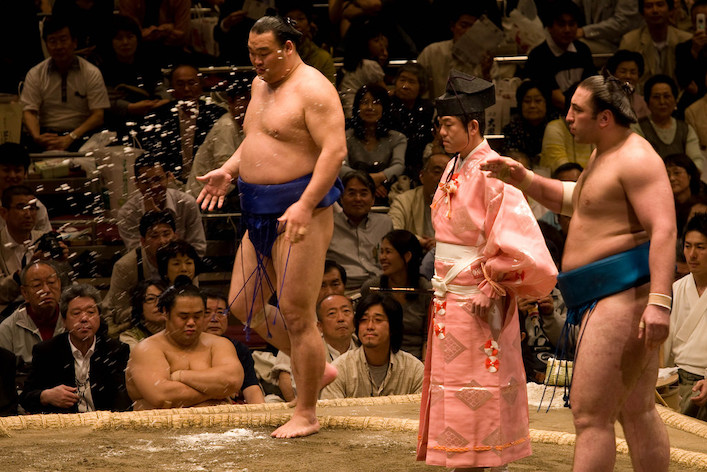
The Challenges of Weight Maintenance:
- Sumo wrestling requires athletes to maintain a high body weight to compete.
- This presents physical and mental challenges for the wrestlers.
- To maintain their weight, sumo wrestlers consume a diet high in calories and protein.
- This often leads to a sedentary lifestyle, which can have negative health impacts.
- The physical strain of carrying excess weight can also lead to joint problems and other health issues.
- Sumo wrestlers must also deal with the mental stress of constantly monitoring their weight.
- This can lead to disordered eating habits and psychological issues.
While maintaining a high body weight is necessary for sumo wrestling, it can also have negative health consequences. Extreme weight gain and loss can increase the risk of heart disease, diabetes, and other health conditions. Additionally, the practice of rapid weight loss and gain can lead to issues with digestion and metabolism.
Addressing Criticisms of the Sumo Wrestling Tradition:
- Some critics argue that the sumo wrestling tradition promotes an unhealthy lifestyle.
- They argue that the emphasis on weight gain and consumption of high-calorie foods is harmful to the wrestlers.
- However, many sumo wrestlers see their sport as a tradition and an important cultural practice.
- They take pride in their ability to maintain their weight and compete at a high level.
- Sumo wrestling also provides opportunities for young men to achieve success and financial stability.
- Despite criticisms, sumo wrestling remains a popular and respected sport in Japan.
In conclusion, weight maintenance is a crucial aspect of sumo wrestling, but it also presents challenges for the athletes. While the tradition has faced criticisms for promoting an unhealthy lifestyle, many wrestlers view it as an important part of their culture and identity. It is important for wrestlers and coaches to prioritize the health and well-being of the athletes, while also respecting and preserving the traditions of sumo wrestling.
Read: The History of Sumo Wrestling: A Deep Dive
Conclusion
Sumo wrestling is an ancient tradition in Japan that requires its athletes to maintain a large body size. Sumo wrestlers use various techniques to maintain their weight, such as a high-calorie diet, rigorous training, and a strict daily routine.
While the methods used by Sumo wrestlers may not be applicable to people in other sports, there are still lessons to be learned. First, a healthy diet is important for maintaining weight, and athletes should focus on consuming nutrient-rich foods that fuel the body. Additionally, a consistent daily routine and rigorous training can help athletes stay on track and maintain their weight.
Overall, Sumo wrestling is a fascinating and unique sport that requires a high level of discipline and dedication. While it may not be suitable for everyone, there are valuable lessons to be learned from the weight maintenance techniques used by Sumo wrestlers.
Read: What are the Basic Rules of Sumo Wrestling?
Before You Go…
Hey, thank you for reading this blog to the end. I hope it was helpful. Let me tell you a little bit about Nicholas Idoko Technologies. We help businesses and companies build an online presence by developing web, mobile, desktop, and blockchain applications.
We also help aspiring software developers and programmers learn the skills they need to have a successful career. Take your first step to becoming a programming boss by joining our Learn To Code academy today!
Be sure to contact us if you need more information or have any questions! We are readily available.
[E-Books for Sale]
1,500 AI Applications for Next-Level Growth: Unleash the Potential for Wealth and Innovation
$5.38 • 1,500 AI Applications • 228 pages
Are you ready to tap into the power of Artificial Intelligence without the tech jargon and endless guesswork? This definitive e-book unlocks 1,500 real-world AI strategies that can help you.
See All 1,500 AI Applications of this E-Book
750 Lucrative Business Ideas: Your Ultimate Guide to Thriving in the U.S. Market
$49 • 750 Business Ideas • 109 pages
Unlock 750 profitable business ideas to transform your future. Discover the ultimate guide for aspiring entrepreneurs today!
See All 750 Business Ideas of this E-Book
500 Cutting-Edge Tech Startup Ideas for 2024 & 2025: Innovate, Create, Dominate
$19.99 • 500 Tech Startup Ideas • 62 pages
You will get inspired with 500 innovative tech startup ideas for 2024 and 2025, complete with concise descriptions to help you kickstart your entrepreneurial journey in AI, Blockchain, IoT, Fintech, and AR/VR.
We Design & Develop Websites, Android & iOS Apps
Looking to transform your digital presence? We specialize in creating stunning websites and powerful mobile apps for Android and iOS. Let us bring your vision to life with innovative, tailored solutions!
Get Started Today
